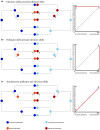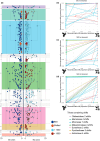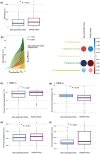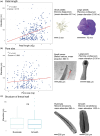Mountain colonization precedes shifts away from bee pollination in Melastomataceae
- PMID: 40484985
- PMCID: PMC12222925
- DOI: 10.1111/nph.70273
Mountain colonization precedes shifts away from bee pollination in Melastomataceae
Abstract
Shifts among different groups of pollinators are central in the evolution of flowering plants, yet mechanisms underlying pollinator shifts remain unclear. Environment-induced reduction in pollinator availability and hence efficiency may destabilize ancestral plant-pollinator interactions and trigger shifts to new, more efficient pollinators, but formal tests remain scarce. We used a series of phylogenetic comparative methods on 333 species of the pantropical family Melastomataceae to test whether elevation, latitude and climatic variables explain pollinator shifts and the distribution of floral traits governing pollen release. We find that shifts away from bee pollination to generalist insect and vertebrate pollination associate with occurrence in cooler and wetter mountain environments. Also, we show that mountain colonization repeatedly preceded and, hence, likely triggered shifts away from bee pollination. Furthermore, our results suggest that the evolution of floral traits (larger petals and pore sizes) facilitating pollen transfer by bees may have been critical for the initial colonization of mountains by bee-pollinated species. By identifying environments conducive to pollinator shifts, our results do not only provide a much-needed hypothesis for mechanisms underlying the evolution of different pollination systems but also confirm their validity through empirical testing. Whether environment-induced evolutionary pollinator shifts are the norm across angiosperms remains to be explored.
Keywords: Melastomataceae; abiotic environmental factors; elevational gradients; floral evolution; pollination syndromes; pollinator shifts.
© 2025 The Author(s). New Phytologist © 2025 New Phytologist Foundation.
Conflict of interest statement
None declared.
Figures





Similar articles
-
High frequency of ambophily in a Brazilian campos de altitude.Ann Bot. 2025 Feb 19;135(3):483-494. doi: 10.1093/aob/mcae176. Ann Bot. 2025. PMID: 39417253
-
High floral disparity without pollinator shifts in buzz-bee-pollinated Melastomataceae.New Phytol. 2024 Jun;242(5):2322-2337. doi: 10.1111/nph.19735. Epub 2024 Apr 17. New Phytol. 2024. PMID: 38634161
-
Pollinator-mediated selection on Krameria oil flowers: a flower-pollinator fit adaptation to an atypical oil-collecting behaviour?Ann Bot. 2024 Oct 30;134(4):603-614. doi: 10.1093/aob/mcae102. Ann Bot. 2024. PMID: 38916514 Free PMC article.
-
A quantitative review of pollination syndromes: do floral traits predict effective pollinators?Ecol Lett. 2014 Mar;17(3):388-400. doi: 10.1111/ele.12224. Epub 2014 Jan 7. Ecol Lett. 2014. PMID: 24393294
-
Global change aggravates drought, with consequences for plant reproduction.Ann Bot. 2025 Feb 8;135(1-2):89-104. doi: 10.1093/aob/mcae186. Ann Bot. 2025. PMID: 39692585 Review.
References
-
- Armbruster WS. 1985. Patterns of character divergence and the evolution of reproductive ecotypes of Dalechampia scandens (Euphorbiaceae). Evolution 39: 733–752. - PubMed
-
- Arroyo MTK, Primack R, Armesto J. 1982. Community studies in pollination ecology in the high temperate Andes of central Chile. I. Pollination mechanisms and altitudinal variation. American Journal of Botany 69: 82–97.
-
- Beaulieu JM, O'Meara BC, Donoghue MJ. 2013. Identifying hidden rate changes in the evolution of a binary morphological character: the corHMM model. Systematic Biology 62: 773–784. - PubMed
MeSH terms
Grants and funding
LinkOut - more resources
Full Text Sources

